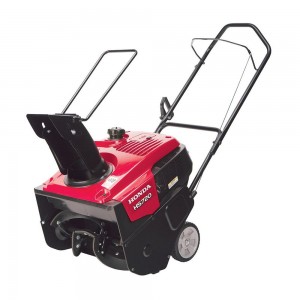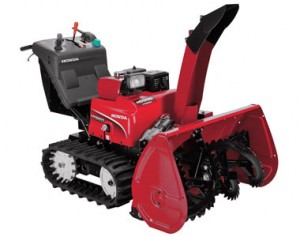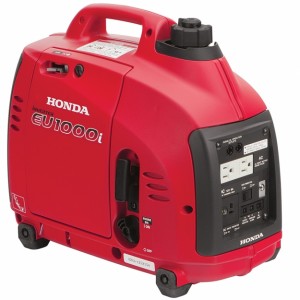 It may be a hybrid, but the HS1336iAS snow blower is as easy to service as any other piece of Honda outdoor equipment. Here’s everything you need to know about keeping this two-stage blower running from adjusting the tracks to changing the oil.
It may be a hybrid, but the HS1336iAS snow blower is as easy to service as any other piece of Honda outdoor equipment. Here’s everything you need to know about keeping this two-stage blower running from adjusting the tracks to changing the oil.
Tool Box
This snow blower has a toolbox built into the back panel with everything you need for maintenance. Here’s what you should find inside.
Tools:
10 and 12 mm box wrench
10 and 14 mm open end wrench
Two 12 and 17 mm open end wrenches
Spark plug wrench and handle
Pliers
Spare parts:
5 blower shear bolts
10 auger shear bolts
15 8 mm lock nuts
2 cotter pins
2 battery terminal covers
5 and 15 amp fuses
Fuse cover
Maintenance Schedule
Each Use: Check engine oil, skid shoes, scraper, shear bolts, and battery electrolyte level.
Each year before use: Change the engine oil. Check the gear reduction oil, spark plug, and tracks.
Every year before storing: Drain the fuel tank and carburetor. Clean the sediment cup. Apply oil to unpainted parts to prevent corrosion.
First month or 20 hours of operation: Change the engine oil and check the tracks.
Every 100 hours: Change the engine oil.
Every four years or 300 hours: Replace the spark plug.
Honda recommends having this snow blower serviced professionally before storage, after the first month or 20 hours of operation and every 300 hours. These services include repairs that are too complex for most owners.
Auger wear will vary depending on the surfaces you operate on. The blades at the end of the auger have wear marks. If the blades are worn down to these marks, the auger should be replaced by a mechanic.
Engine Oil
The dipstick is located on the right side of the snow blower next to the tracks. When checking the oil level, do not screw the dipstick into the hole.
To change the oil, place a drain pan on the right track. Remove the dipstick and unscrew the 10 mm drain bolt directly below the filler neck. Once the crankcase is empty, reinstall the drain bolt, using a new washer.
Honda recommends 5W30 motor oil that meets API service category SJ or later. The oil level should come up to the edge of the filler neck. The iGX390 holds 1.16 quarts.
Spark Plug
The plug is behind the muffler. The plug gap should be between 0.028 and 0.031 inches or 0.7-0.8 mm.
Track Adjustment
The tracks must be clean and dry to get accurate measurements. To check the tension, push down on the top middle section of the track with 22 lb-ft. of force. The track should deflect 0.62-0.79 inches (16-20 mm.)
To adjust the track tension, loosen the lock nut on the tension bolt, located just behind the front wheel. Turn the adjusting nut until the track tension is correct, then tighten the lock nut.
Shear Bolt Replacement
1. Turn the auger clutch switch to “Off.”
2. Release the drive clutch lever.
3. Set the auger to its lowest position.
4. Turn the engine off and remove the key. Let the snowblower come to a complete stop.
5. Look over the snow blower for signs of debris or damage that may have caused the bolt to break.
6. Remove the broken bolts and replace them with new shear bolts and lock nuts.
Batteries and Fuses
To access the batteries, loosen the two knobs on the sides of the rear cover. Rotate the rear cover down and slide it off of the snow blower. The fuses are inside a box directly above the batteries.
The electrolyte level should be between the “Lower Level” and “Upper Level” marks on the side of the battery case. If the level is low, remove the caps from the top of the battery and add distilled water. Clean any corrosion on the battery terminals with baking soda and water.
To remove the batteries, disconnect the negative cable from the left battery, followed by the positive terminal on the right battery. Loosen the nuts holding the battery clamp, then disconnect the joint cable from the left battery’s positive terminal, then the right battery’s negative terminal. Remove the batteries from the snow blower. When reinstalling the batteries, connect them in the reverse order you disconnected them.
Charge the batteries individually. The output of each battery should be within 10% of 35 Ah. Charge the battery at 3.5 amps for 5-10 hours.
Need Parts?
If you need some shear pins, an oil plug washer or even a new toolkit, you can get it from www.hondalawnparts.com. We’re a certified dealer for Honda Power Equipment and Honda Engines, which means we carry OEM replacements for everything on your snow blower. Our site has built-in factory information including diagrams and descriptions, making it easy to find compatible parts for your model.



